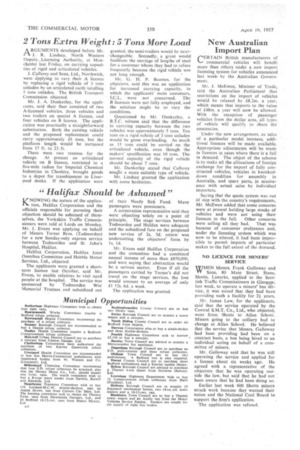2 Tons Extra Weight: 5 Tons More Load A RGUMENTS developed
Page 38

If you've noticed an error in this article please click here to report it so we can fix it.
before Mr. 3, R. Lindsay, North Western Deputy-Licensing Authority, at Manchester last Friday, on carrying capacities of rigid and articulated vehicles.
J. Cafferey and Sons, Ltd., Northwich, were pplying to vary their A licence by replacing a rigid vehicle of 3 tons unladen by an articulated outfit totalling 5 tons unladen. The British Transport Commission objected.
Mr. J. A. Dunkerley, for the applicants, said their fleet consisted of two A-licensed vehicles, three vehicles and Iwo trailers on special A licence, and four vehicles on B licence. The application was practically a straightforward substitution. Both the existing vehicle and the proposed replacement could carry approximately 10 tons, but the platform length would be increased from 17 ft. to 23 ft.
There were two reasons for the change. At present an articulated vehicle on B licence, restricted to a five-mile radius for Imperial Chemical Industries in Cheshire, brought goods to a depot for transhipment to Liverpool docks. If the application were granted, the semi-trailers would be interchangeable. Secondly, a grant would facilitate the carriage of lengths of steel for a customer whom they had to refuse frequently because the rigid vehicle was not long enough.
Mr. G. H. P. Beames, for the objectors, said this was an application for increased carrying capacity, in which the applicants' main customers. ICJ., were not concerned. The B licences were not ftilly employed, and the solution might be to. vary the conditions.
Questioned by Mr. Dunkerley, a B.T.C. witness said that the difference in carrying capacity between the two vehicles was approximately 5 tons. Ten tons on a rigid vehicle of 3 tons unladen would be gross overloading. As much as 15 tons could be carried on the articulated vehicle, even though the makers' specification was 10 tons. The normal capacity of the rigid vehicle should be about 7 tons.
Mr. Dunkerley stated that Cafferey sou& a more suitable type of vehicle.
Mr. Lindsay granted the application with some hesitation.




























































































